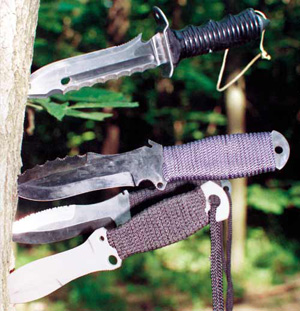The Basic Principles Of Knife Throwing Guide
The wood was slightly soft from termites and insects gnawing at it, so the knives stuck much easier than normal, which was perfect for practice for a teenage lady such as myself. I actually found that I chose the heavy-grip locking switch blades for throwing and street fighting; they had style in the handle and blade, but were well balanced, compact, and surprisingly long lasting, on top of the fact that they're legal as a hidden weapon in the state of Texas; I could take them practically anywhere.



I'm told that while I wouldn't win a contest for the force of my tosses and depth of blade entry into the target, my speed and precision is completely remarkable. It's crucial when ending up being a knife thrower to decide not only what blades are best for you, however also what areas you wish to be best at.
The curve of the knife from hilt to tip makes it challenging for a beginner, but with practice it ends up being a really reliable tossing knife and is excellent for close hand fight. It's sturdy enough that in over 5 years of throwing and general use it has actually not broken; on top of that, it is styled and not dull or plain.

The Gil Hibben Total Knife Throwing Guide is considered the # 1 volume on the topic of knife throwing. From newbie to professional, this important resource includes every element of the age-old art. THE COMPLETE KNIFE THROWING GUIDE (Hibben)( 65 Pages, Diagrams and Photos).
Knife Throwing Guide for Beginners
$ 9. 95 At Our Partner Storage Facility - Normally Ships in 4-8 Service Days Description Knife Throwing is the most authoritative guide on every aspect of the sport. From knives and knife throwing methods to competitors and suggestions, as well as profiles of leaders and legends in the field, this book covers all of it.
Rather, for the huge bulk of throwers, the physics involved consists of both lateral movement and rotation as the knife circle its center of gravity on the way to the target. The secret is to be consistent. The knife thrower must release the knife in precisely the exact same way and at exactly the same position each and every time.
The ideal length will lead to a stick, so you need to toss from that point each time. How do you find that range? The math involved is simple: If the thrower holds the knife by the manage, it requires room to make one total revolution (or a specific multiple of that length).
Trajectory The knife turns as it flies through the air. If you want to dive deeper, then the physics and human kinesiology behind the act end up being a little bit more involved. It begins with the arm-shoulder movement of the thrower, which traces out a circular course around the shoulder joint. During this act, while the knife remains in the thrower's hand, the knife's primary axis continually alters the angle it makes with the ground; much like the previously owned of a watch (only much quicker).
A Biased View of Knife Throwing Tips
As soon as the knife leaves the thrower's hand, it progresses through the air while continuing to turn around its center of mass. On a typical a throwing tool, the center of mass sits midway in between completion of the manage and the blade tip. Both ends of a balanced knife will trace out equal circles as it flies through the air.
read more get more info click here